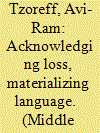| Srl | Item |
| 1 |
ID:
192279


|
|
|
|
|
| Summary/Abstract |
This article focuses on Rabbi Yosef Hayyim's discussions of translation and hermeneutics, as a reflection of the broad movements between languages throughout the Ottoman Empire and the Indian Ocean, and the linguistic inequalities that characterized them. Reading Hayyim against his Baghdadi context, considering the printing and translational activities of the British missionaries of the London Society for Promoting Christianity amongst the Jews and the hermeneutics that were developed in the Baghdadi Salafiyya, I argue that Hayyim's opposition to the translation of Jewish Kabbalistic knowledge should not be seen as a conservative approach that prevents its popularization, but as an understanding of the linguistic power relations involved within the act of translation. Juxtaposed vis-à-vis his uses of Arabic translations in other responsas and his call for the teaching of standard Arabic in Jewish schools in Baghdad, that cohered with the Nahdawi perception of Arabic as a major aspect of the Ottoman Mashriq Arab political community, I argue that these incidents reflect different intersections of languages and power that occurred in the urban sphere of Ottoman Baghdad.
|
|
|
|
|
|
|
|
|
|
|
|
|
|
|
|
| 2 |
ID:
169980


|
|
|
|
|
| Summary/Abstract |
This article investigates the spread of Zionism in the Jewish communities of Transylvania devoting special attention to the cultural mediation of the Jewish newspaper, Új Kelet (New East). Considering representative issues of the Jewish daily, Új Kelet, within 10 years of its inception (from the 1920s), will allow me to describe its key role as the foremost communications outlet for the promotion of Zionist ideas and activities in Transylvania. I will further trace the impact of this newspaper on the life and writings of Isaiah Tishby (1908–1992), one of the preeminent scholars of Kabbalah in the twentieth century, who was exposed to the Jewish daily in his youth and became indelibly transformed by it after its precipitous launch in 1918 on the heels of World War I.
|
|
|
|
|
|
|
|
|
|
|
|
|
|
|
|